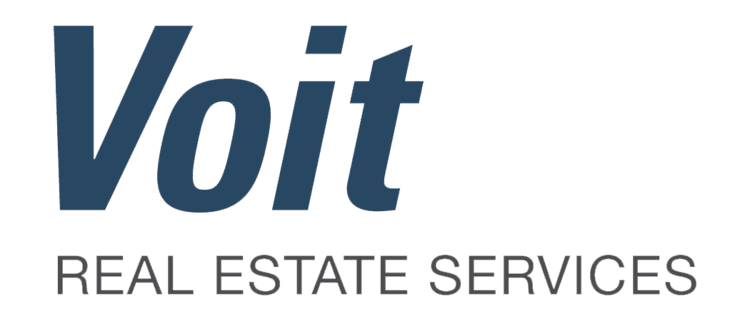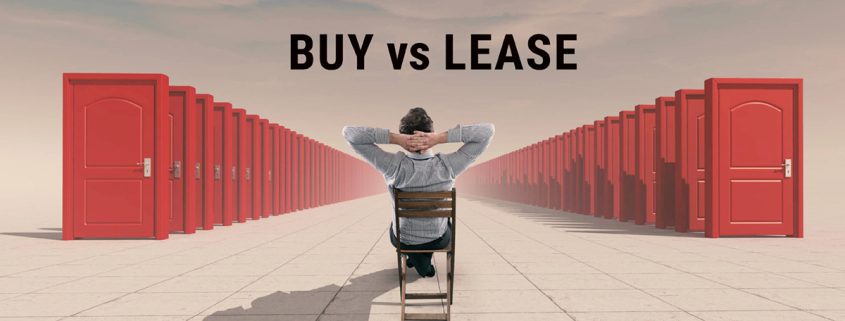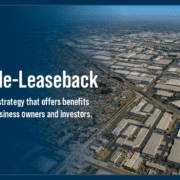Lease or Buy Decisions Complicated by Market Uncertainty
When seeking out a commercial property to either start or grow their company, business owners are often faced with the question: Should I lease or buy? There is no one-size-fits-all solution, and the best strategy for any company depends on many factors, including the property type and the market in which the business is located. But given today’s uncertain market conditions, that decision has taken on added layers of complexity, specifically the unpredictability of the economy and the radical transformation of the office market.
The Economy
Following 11 interest rate hikes over the last 18 months designed to bring down inflation from its 40-year high, the Fed last week adopted a wait-and-see attitude before implementing any more increases. The good news is that the decision keeps the benchmark lending rate in the range of 5.25% to 5.50%, which, although higher than it has been in 22 years, is not exceptionally high from a historical perspective (it was above 19% from 1980-1981 and at 5.25% as late as 2006-2007). In addition, the Fed revised GDP growth upwards, and it’s now expected to increase 2.1% for the year, easing fears of an imminent recession.
The downside to the announcement is that the Fed also signaled that the rate cuts anticipated by many economists next year would most likely come at a slower pace than initially predicted – meaning that commercial real estate lending activity may remain stalled well into 2024. So those looking to purchase properties for their own company’s use may have difficulty getting financing or will pay a higher rate.
The Office Market
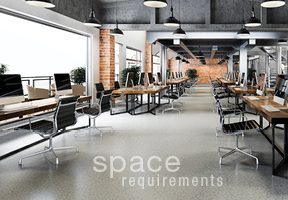
Office-using business owners trying to decide whether to lease or buy have had their decision-making process further muddled by the pandemic’s effect on the traditional working model. As companies struggle to strike the right balance for a hybrid work model that satisfies both company objectives and employee preferences, it may be some time before firms can accurately predict what size building will suit their needs. For owners who do decide to purchase their own buildings, is it better to buy a property now or to wait to see if distressed properties become available? Will owners, unable to meet their debt obligations or no longer in need of as much space, sell at bargain prices?
The Pros and Cons of Buying and Leasing
The advantages and disadvantages of owning versus leasing have been fairly well-documented. Our in-depth blog article Lease vs. Buy: Pros and Cons helps business owners weigh occupancy costs versus rental costs to determine whether leasing or user-ownership is the right path for their business.
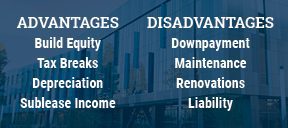
Buying – There are a number of advantages to buying and occupying a property. For starters, purchasing a building allows the business owner the opportunity to build equity, as assets historically tend to appreciate (although some B&C office buildings and functionally obsolete warehouses may be the exception in today’s market). There are tax breaks (interest, depreciation, and non-mortgage expenses), and some owners may be able to generate additional income from the property by renting out excess space in the building.
The downsides for companies looking to become owner-occupiers begin with the upfront costs of a downpayment, as well as the cost of renovations and banking fees. Lenders typically require between 10% (through an SBA loan) to 50% of the commercial property’s total value, but with lending standards tightening – particularly for office properties – the loan-to-value (LTV) ratio could be considerably lower. Once the property is purchased, all maintenance and repair costs are the owner’s responsibility, which is why due diligence (with the assistance of a trusted commercial real estate advisor/broker) is essential to the acquisition process. And for those considering renting out excess space in their property, liability can be a concern.
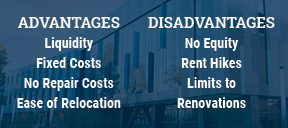
Leasing – On the plus side, business owners have the predictability of fixed real estate costs, with no initial investment and no cash outlays for repairs and maintenance. There is far more liquidity, and business owners can deploy their cash into improving and expanding their business rather than investing in real estate expenses. Tenants also have the luxury of walking away from the space if they choose to move to a better location, expand, or find a better deal. The downside to renting is that tenants don’t accumulate equity (unless it’s a lease-to-own agreement) and – as industrial users have found in recent years – dramatic rent increases that can dramatically impact a company’s bottom line.
Other Considerations
While a list of advantages and disadvantages for both options is helpful, there are several other variables to consider when deciding whether buying or leasing is right for your business. For instance, buying a property may only make sense if the company is relatively stable and not likely to expand beyond the capacity of the building. Conversely, a strong case can be made for purchasing a building that is designed for a purpose, i.e., a building with a substantial amount of business-specific infrastructure within the facility. Because relocating and replicating that infrastructure would be cost-prohibitive, the tenant has little leverage with the building owner when it comes to renewing their lease.
Know Your Market
Industrial – In Southern California markets, the demand for industrial space remains strong despite slight softening in some submarkets. The continued growth of e-commerce, the expansion of logistics and distribution centers, and the need for more space for manufacturing and warehousing ensure that it should remain that way for the foreseeable future, especially when coupled with a slowdown in development due to escalating land and construction pricing and interest rate hikes. Although vacancy rates have ticked up in 2023, they remain historically low, hovering at or below the 3% range in most submarkets. Despite the record-high pricing for industrial assets and the uncertain interest rate environment, acquiring a property may still make sense for business owners looking to control occupancy costs long-term. SBA loans are still an attractive financing option for smaller operators seeking to purchase a building. Working closely with a broker may also uncover off-market deals in this overheated investment sales market.
Office – The office market for much of Southern California continues to fare poorly despite the return-to-office mandates being instituted by many companies. According to Commercial Edge National Office Report for September, Los Angeles and San Diego vacancy rates are approximately 16% for “full-service” spaces available for rent, with a listing rate of $43.85 for San Diego and $42.00 for Los Angeles, both among the highest in the nation. More telling, however, is that the sale price for Class A buildings, which nationally fell 35% compared to a year ago, from $361 per square foot (PSF) to $233. San Diego remains among the highest at $408 PSF on $525 million in 2023 sales transactions, while LA is in the middle of the pack at $231 PSF on $1.2 billion in sales. For business owners seeking bargains, the market bears watching in 2024.
Conclusion
While economic uncertainty and the disruption of the office market have introduced more factors to consider in the decision to buy or lease a commercial property, business owners can ensure a more thorough decision-making process by contacting an experienced broker with a deep understanding of the local market. Visit the Voit Meet Your Team page to find a broker to assist you in your property search.
